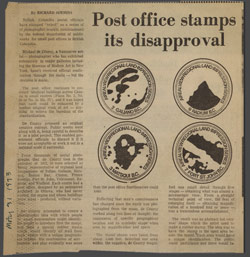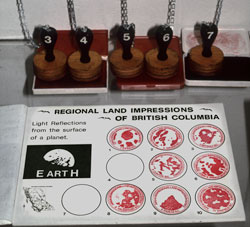Post office stamps its disapproval
THE PROVINCE - Thursday, May 31,1973
By Richard Simmins
Michael de Courcy, a Vancouver artist-photographer who has exhibited extensively in major galleries including the Museum of Modern Art in New York, hasn't received official confirmation through the mails— but the decision is made.
The post office continues to construct identical buildings across Canada in small centers (Plans No. 2, 3b or No. 5s MK. IV) and it was hoped that each could be enhanced by a modest original work of art — anything to relieve the boredom of the standardization.
de Courcy proposed an original creative concept. Public works went along with it , being careful to describe it as a pilot project. This enabled the government officials discard it if it =were not acceptable or work it out on a national scale if it were successful.
From thousands of aerial photographs de Courcy took in the summer of 1972, 10 were selected as being representative of regional land impressions of Tofino, Galiano, Matsqui, Boston Bar, Clinton, Prince George, Fort St. John, Valemont, Radium, Winfield. Each center had a post office, designed by an uninspired architect in Ottawa, who had never visited the region and whose buildings were massed produced without variation.
De Courcy attempted to create a photographic idea with which people in small communities might identify. He sought to introduce first the mural, and then a special rubber stamp which would identify all mail from each center with a unique geographical symbol. His combination of seriousness and play evidently was more than the post office functionaries could take.
Reflecting that man's consciousness has changed since the earth was photographed from the moon, de Courcy worked along two lines of thought: the uniqueness of specific geographical location and its when seen by magnification from space.
The mural photos were taken from about 5000 feet. Selecting one area within the negative de Courcy magnified one small detail through five stages — obtaining what was almost a microscopic view. From a straight technical point of view, the feat of enlarging itself — obtaining magnification of a hundred fold or more — was a tremendous accomplishment.
Naturally there was no consultation with any of the small communities. No one in Tofino or Radium were asked their opinion.
Rather than get involved in art judgements, the bureaucrats threw in arguments about a new education for the public which will be necessary as the system becomes more and more automated. No consideration was given to the positive public relations aspect. of de Courcy's imaginative works. Acceptance might have brought international comment on an organization that has no image, is plagued by employee unrest and public indifference.
The post office will survive without de Courcy. There will still be pictures of the queen or as in the sub postoffice I go to , pseudo- Mexican bullfight posters, miniaturized and framed.
All is not lost however.
The murals and rubber stamps, paid for, will be carefully packed and sent to Ottawa for storage along with horse blankets, plaster casts of lion and unicorn which the post office has been quietly been removing from its buildings for years and dated toothy photographs of royalty long since aged.
Perhaps the postmaster will present B.C. officials with a special plaque for upholding mediocrity and doing nothing to change a sterile image.

